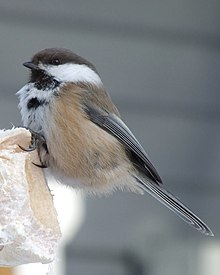| Grey-headed chickadee | |
|---|---|

| |
| Scientific classification | |
| Domain: | Eukaryota |
| Kingdom: | Animalia |
| Phylum: | Chordata |
| Class: | Aves |
| Order: | Passeriformes |
| Family: | Paridae |
| Genus: | Poecile |
| Species: | P. cinctus
|
| Binomial name | |
| Poecile cinctus (Boddaert, 1783)
| |

| |
| Range of Poecile cinctus | |
| Synonyms[2] | |
|
Parus cinctus | |

The grey-headed chickadee or Siberian tit (Poecile cinctus), formerly Parus cinctus, is a passerine bird in the tit family Paridae. It is a widespread resident breeder throughout subarctic Scandinavia and the northern Palearctic, and also into North America in Alaska and the far northwest of Canada. It is a conifer specialist. It is resident, and most birds do not migrate. Curiously (with respect to its name), the bird has no grey on its head, which is black, white, and brown.
It is a fairly large tit, 13.5–14 cm long with a weight of 11–14.3 g. The head is dark brown with white cheeks, the mantle brown, the wing feathers blackish with pale fringes, and the underparts whitish with pale brown flanks.
Ecologists in Folldal, Hedmark, Norway found that the Siberian tits accounted for only 1% of all tit individuals in lichen-dominated pine forest in 2011 as opposed to 64% in 1982. This dramatic reduction is attributed to the interspecies competition with the willow tits and great tits, decreased vegetation due to climate change, and logging of old-growth trees which are preferred over new-growth trees .[3]
- ^ BirdLife International (2016). "Poecile cinctus". IUCN Red List of Threatened Species. 2016: e.T22711750A87424950. doi:10.2305/IUCN.UK.2016-3.RLTS.T22711750A87424950.en.
- ^ "Poecile cinctus". Avibase.
- ^ Dale, Svein; Andreassen, Ellen T. (April 2016). "Population decline of the Siberian Tit (Poecile cinctus) in southern Norway and an assessment of possible causes". Ornis Fennica. 93 (2): 77–87. doi:10.51812/of.133890.
